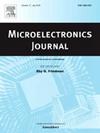具有无源战壕MOS和战壕屏蔽SBD的无反弹和快速反向恢复能力的RC IGBT
IF 1.9
3区 工程技术
Q3 ENGINEERING, ELECTRICAL & ELECTRONIC
引用次数: 0
摘要
提出了一种基于被动式战壕MOS和战壕屏蔽SBD的无snapback快速反向恢复能力RC IGBT,并进行了仿真研究。PT-MOS在Collector上被介绍。通过n缓冲层将PT-MOS的栅极和源端短路,实现了不需要额外输入信号的反向导通能力。此外,肖特基势垒二极管(SBD)集成在发射极。SBD由双沟门屏蔽。因此,击穿电压不会受到SBD的影响。在正向导通阶段,PT-MOS处于非状态。反弹被p阱电子势垒消除。在反导阶段,PT-MOS和SBD自动导通,实现反导能力。在反采阶段,SBD可以有效抑制体二极管的孔注入,从而显著降低反采电荷。仿真结果表明,与传统RC IGBT和FPL IGBT相比,本文提出的IGBT分别减少了67%和76.5%的反向采油费用。在相同的关断损耗EOFF为29 mJ/cm2的情况下,与Con IGBT和FPL IGBT相比,Pro IGBT的导通电压VON分别降低了40%和11%。本文章由计算机程序翻译,如有差异,请以英文原文为准。
A snapback-free and fast reverse recovery capability RC IGBT with passive trench MOS and trench shield SBD
A Snapback-Free and fast reverse recovery capability RC IGBT featuring the Passive Trench MOS and trench shield SBD is proposed and investigated by simulation. The PT-MOS is introduced at the Collector. The gate and the source of PT-MOS was shorted by the N-buffer layer, which realizes the reverse conduction ability without additional input signal. Additionally, the Schottky Barrier Diode (SBD) is integrated at Emitter. The SBD is shield by dual trench gates. Thus, the breakdown voltage will not be affected by the SBD. During forward-conduction stage, the PT-MOS is off-state. The snapback is eliminated by the P-well electron barrier. During backward-conduction stage, the PT-MOS and SBD are turn-on automatically to achieve reverse conducting ability. During reverse recovery stage, the SBD can effectively suppress hole injection from the body diode, thereby significantly reducing the reverse recovery charge. The simulation results indicate that, compared with conventional RC IGBT and FPL IGBT, the Proposed IGBT achieves a 67 % and 76.5 % reduction in reverse recovery charge, respectively. At the same turn-off loss EOFF of 29 mJ/cm2, the on-state voltage VON of the Pro IGBT is reduced by 40 % and 11 % compared to the Con IGBT and FPL IGBT, respectively.
求助全文
通过发布文献求助,成功后即可免费获取论文全文。
去求助
来源期刊

Microelectronics Journal
工程技术-工程:电子与电气
CiteScore
4.00
自引率
27.30%
发文量
222
审稿时长
43 days
期刊介绍:
Published since 1969, the Microelectronics Journal is an international forum for the dissemination of research and applications of microelectronic systems, circuits, and emerging technologies. Papers published in the Microelectronics Journal have undergone peer review to ensure originality, relevance, and timeliness. The journal thus provides a worldwide, regular, and comprehensive update on microelectronic circuits and systems.
The Microelectronics Journal invites papers describing significant research and applications in all of the areas listed below. Comprehensive review/survey papers covering recent developments will also be considered. The Microelectronics Journal covers circuits and systems. This topic includes but is not limited to: Analog, digital, mixed, and RF circuits and related design methodologies; Logic, architectural, and system level synthesis; Testing, design for testability, built-in self-test; Area, power, and thermal analysis and design; Mixed-domain simulation and design; Embedded systems; Non-von Neumann computing and related technologies and circuits; Design and test of high complexity systems integration; SoC, NoC, SIP, and NIP design and test; 3-D integration design and analysis; Emerging device technologies and circuits, such as FinFETs, SETs, spintronics, SFQ, MTJ, etc.
Application aspects such as signal and image processing including circuits for cryptography, sensors, and actuators including sensor networks, reliability and quality issues, and economic models are also welcome.
 求助内容:
求助内容: 应助结果提醒方式:
应助结果提醒方式:


